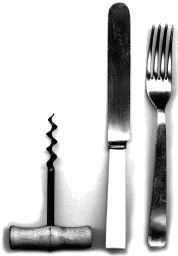Issue
Article
Vol.28 No.4, October 1996
Article
Issue
Issue |
Article |
Vol.28 No.4, October 1996 |
Article |
Issue |

What's the difference between a lamb and a salmon?
In terms of the taste and the sort of culinary creation that can be produced with them there is a world of difference, but in terms of how the two are pronounced in the Dutch language there is very little difference (zalm and lam) and if you just happen to be pronouncing them in a busy and loud restaurant then the difference is almost imperceptible.
Those readers familiar with working in restaurants will already be wincing at this point. The danger is that the waiter will stick his head through the kitchen door and yell `one steak, one lamb'. Twenty minutes later he'll walk to the customers table with one steak and one salmon!
What's the solution? Start running a vegetarian restaurant? Shout louder? No. The answer is to redesign the language. In Dutch restaurants if there is a lamb dish on the menu it is often given a different name, the name of the dish, the french name for lamb whatever, as long as it isn't called lamb.
When you get down to it this is effectively the design of syntax and semantics of a dedicated command language (but don't try to tell this to the waiter). It is the configuration of a system of communication to make it more friendly to those using it. The nature of the problem is that you have two very different dishes with very similar names. A small mistake in yelling the name or in hearing it can lead to a big difference in the results. The syntax elements are similar but the semantics are very different.
Similar things happen with information systems, That terrible program where the bottom choice on the menu is `save all information' and the one just above it is `exit without saving'. The commands are syntactically close (a matter of shifting the mouse 2 millimeters), but they are very different in the results, a combination that leads to disastrous results.
Peter `hips' Boersma used to work in a pizzeria and there they developed a pizza shorthand. The idea was that each pizza had a name that was totally unconfusable. This was not as easy as it sounds. The quattro stagioni was obviously shortened to a `quattro', and to avoid confusion the quattro formaggio was a `cheese'. For a while the quattro salumi (something to do with sausages) was shortened to `salumi' but this was syntactically too close to `salami'.
Another pizzeria trick was the garlic. Customers could choose pizzas with or without garlic sauce. The garlic sauce was invisible and if you had two salami pizzas, one with garlic and the other without there was no way of telling which was which without starting to eat them. A golden rule for feedback for software, products or even food is `make the invisible visible'. Visible information is faster to access and process. The solution to the garlic problem was to put visible bits of garlic on those pizzas treated with the invisible garlic sauce.
In fact, when it comes to cooking, feedback plays a vital role in all its forms. It is one of the few areas where taste feedback is used in controlling actions; seasoning a dish and tasting it until it is exactly what you want. Tactile feedback is also used; stirring a sauce until you feel it thickening against the spoon. Audio, turning the gas up or down purely on the basis of the whistling noise that the gas jets are making. Smell; something's burning. And visual; basically watching what your doing!
All this feedback is somehow natural. In contrast the world of software and products uses feedback that is artificially added to the system in order to help the user, the beep signals, the red LEDs and so on. However, there are instances in the culinary world where artificial feedback is added to a system in order to help the user. Welcome to the `white sauce syndrome'. The chef is cooking a set menu, she has a white sauce for the fish, a white sauce for the cauliflower and a white custard for the desert. If you are going to pour one of the sauces on the fish you need to know which sauce is which, obviously they taste different but to make things faster you need some visual feedback. Thus cooks will often modify the recipe so that they can see what is going on; putting a few bits of mint in the custard or capers in the fish sauce.
So the next time you're in a restaurant spare a thought for the poor cook struggling to meet your order in a steamy, noisy world of poor feedback and badly designed languages!
Lon Barfield
Lon Barfield is the author of `The User Interface, Concepts and Design' (Addison Wesley) and is an associate director of General Design (http://www.design.nl). He can be contacted at lon@design.nl.
Issue |
Article |
Vol.28 No.4, October 1996 |
Article |
Issue |